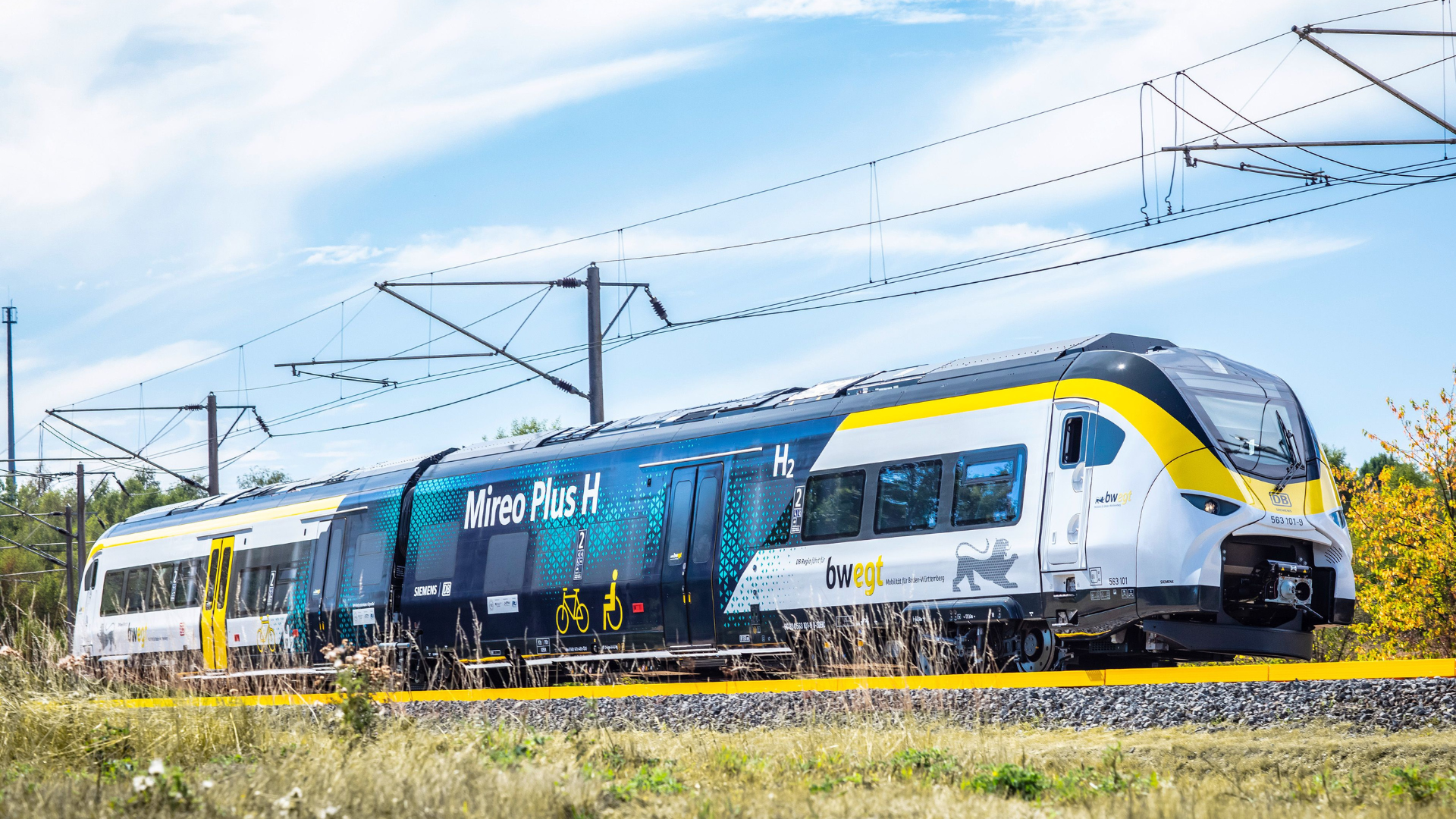
As the rail transport industry steers towards sustainable future operations, leading rolling stock manufacturers Siemens Mobility AG and Stadler Rail AG are currently testing their hydrogen rail units - powered by Ballard fuel cells - in Germany and the United States. These hydrogen-powered models are poised to replace traditional diesel-driven trains in certain applications, providing an emissions-free alternative for passenger and freight transportation on non-electrified routes.
Siemens Mobility Mireo Plus H
One of the front-runners in this technological shift is Siemens Mobility's hydrogen train platform, named "Mireo Plus H", the first prototype developed in collaboration with Deutsche Bahn and Ballard. This train boasts a range of 800 kilometers and can reach speeds up to 160 km/h.
 The Mireo Plus H is currently undergoing rigorous testing to ensure its viability in everyday conditions. Initial tests are taking place in Southern Germany with Deutsche Bahn in Baden-Wurttemberg on routes starting from Tübingen, and with a second prototype for the Bayerische Regiobahn (BRB) in Bavaria, on routes starting from Augsburg. This phase will assess the trains under various seasonal conditions—winter trials aim to evaluate performance in low temperatures and summer trials will focus on high-temperature efficiency and hydrogen consumption.
The Mireo Plus H is currently undergoing rigorous testing to ensure its viability in everyday conditions. Initial tests are taking place in Southern Germany with Deutsche Bahn in Baden-Wurttemberg on routes starting from Tübingen, and with a second prototype for the Bayerische Regiobahn (BRB) in Bavaria, on routes starting from Augsburg. This phase will assess the trains under various seasonal conditions—winter trials aim to evaluate performance in low temperatures and summer trials will focus on high-temperature efficiency and hydrogen consumption.
An important aspect of the trials is geography and topography. To gain more experience on fuel cell performance on hilly routes, Southern Germany with the Bavarian Alpine foothills and the Black Forrest are well-chosen areas for testing.
A crucial part for future passenger and freight transportation is reachable distance with one tank of hydrogen and the refueling process. The Mireo Plus H has a range of between 1,000 and 1,200 km on one tank of fuel, and refueling takes only 15 minutes. Facilitated by a new infrastructure set up, special refueling tests are done in Southern Germany. Successful completion of these tests will see the Mireo Plus H expand its operation to routes from Tübingen to Horb and Pforzheim, currently served by diesel trains.
Seven Mireo Plus H trains are currently being prepared for the transit operator Niederbarnimer Eisenbahn (NEB) in the Berlin-Brandenburg region. The trains are being built at the Siemens Mobility Factory in Krefeld and factory-tested at the Proving Center Wegberg-Wildenrath (PCW) near Mönchengladbach.
Stadler Flirt H2
Stadler, another leading rolling stock manufacturer, is also preparing its Flirt H2 commuter train for future operations. The Flirt H2 consists of two electrically powered end cars and a power pack in the middle, containing fuel cells and hydrogen tanks. Tests on the Flirt H2 were initially done in Switzerland and more recently on a test track in Colorado.
 In March 2024 the FLIRT-H2, powered by six Ballard FCmove®-HD+ fuel cells, traveled a distance of 2,803 km in 42h without refueling or recharging. It has set a new benchmark, that earned the Guinness World Record award for the longest distance covered by a hydrogen-powered passenger train between refueling.
In March 2024 the FLIRT-H2, powered by six Ballard FCmove®-HD+ fuel cells, traveled a distance of 2,803 km in 42h without refueling or recharging. It has set a new benchmark, that earned the Guinness World Record award for the longest distance covered by a hydrogen-powered passenger train between refueling.
With 108 seats, a top speed of around 130 km/h according to the manufacturer and designed for ambient temperatures of up to 49 °C, the FLIRT-H2 is an emission-free alternative for non-electrified routes in North America. Caltrans, the transportation authority of the state of California, already has ordered several hydrogen trains.
The development and testing of these hydrogen trains are indicative of a broader shift towards sustainable transportation solutions. As the trains continue to be tested and refined, the technology demonstrates both maturity and potential to offer a viable and environmentally friendly alternative to diesel, particularly on routes where electrification is impractical.




 The Mireo Plus H is currently undergoing rigorous testing to ensure its viability in everyday conditions. Initial tests are taking place in Southern Germany with Deutsche Bahn in Baden-Wurttemberg on routes starting from Tübingen, and with a second prototype for the Bayerische Regiobahn (BRB) in Bavaria, on routes starting from Augsburg. This phase will assess the trains under various seasonal conditions—winter trials aim to evaluate performance in low temperatures and summer trials will focus on high-temperature efficiency and hydrogen consumption.
The Mireo Plus H is currently undergoing rigorous testing to ensure its viability in everyday conditions. Initial tests are taking place in Southern Germany with Deutsche Bahn in Baden-Wurttemberg on routes starting from Tübingen, and with a second prototype for the Bayerische Regiobahn (BRB) in Bavaria, on routes starting from Augsburg. This phase will assess the trains under various seasonal conditions—winter trials aim to evaluate performance in low temperatures and summer trials will focus on high-temperature efficiency and hydrogen consumption. In March 2024 the FLIRT-H2, powered by six Ballard FCmove®-HD+ fuel cells, traveled a distance of 2,803 km in 42h without refueling or recharging. It has set a new benchmark, that earned the Guinness World Record award for the longest distance covered by a hydrogen-powered passenger train between refueling.
In March 2024 the FLIRT-H2, powered by six Ballard FCmove®-HD+ fuel cells, traveled a distance of 2,803 km in 42h without refueling or recharging. It has set a new benchmark, that earned the Guinness World Record award for the longest distance covered by a hydrogen-powered passenger train between refueling.